
Quantum Efficiency Tester
PL/EL Integrated System
PV-Reflectumeter
3D Confocal Microscope
In-Line Four Point Probe Tester
Four Point Probe Tester
In-Line Thin Film Thickness Tester
Raman Spectrometer
FTIR Spectrometer
Spectrophotometer
Automatic Spectroscopic Ellipsometer
Contact Resistance Tester
Ultra depth of field 3D microscope
Auto Visual Tester
VMM PV Vision Measuring Machine
Solar Cell Horizontal Tensile Tester
Steady State Solar Simulator for Solar Cell
Solar Cell UV Aging Test Chamber
Solar Cell Comprehensive Tensile Tester
Visual Inspection Tester
Wet Leakage Current Tester
PV Module EL Tester
PV Module UV Preconditioning Chamber
Steady State Solar Simulator for PV Module
Current Continuous Monitor
Potential Induced Degradation Test
Bypass Diode Tester
LeTID Test System
Reverse Current Overload Tester
Impulse Voltage Tester
Hipot Insulation Tester
Ground Continuity Tester
Hipot Insulation Ground Tester
Damp Heat Test Chamber
Humidity Freeze Test
Thermal Cycle Test Chamber
Dynamic Mechanical Load Tester
Static Mechanical Load Tester
Hail Impact Tester
Robustness of Termination Tester
Module Breakage Tester
Cut Susceptibility Tester
Peel Shear Strength Tester
Universal Testing Machine (Single-arm)
Universal Testing Machine (Double-arm)
Glass Transmittance Tester
Acetic Acid Test Chamber
EVA Degree of Crosslinking Test System
Junction Box Comprehensive Tester
Drop ball tester
Semi-automatic scanning four-probe tester
Stylus Profilometer
Maximum Power Point Tracker
Perovskite Glass Transmittance Tester
Perovskite P1 Laser Scribing Multifunctional Testing Machine
Perovskite Online PL Tester
Perovskite Online Sheet Resistance Tester
Online Perovskite Film Thickness Tester
Perovskite Process Inspection Workstation
Portable IV Curve Tester
Portable EL Tester
Portable Thermal Imaging Tester
Solar Module Multi-Channel Testing System
PV Inverter Power Quality Tester
Drone EL Tester
IV Tester
IVEL Cell Sorting Machine
Efficiency of 25.62% and self-assembled π-conjugated molecules for UV UV-resistant high-efficiency chalcogenide cells
Date : 2025-07-23Views : 95
A key challenge in chalcogenide solar cells (PSCs), especially in inverted (p-i-n) structured PSCs, is the interfacial degradation due to ultraviolet (UV) irradiation that severely affects device stability. In this study, we report two novel thiophene-modified self-assembled π-conjugated hole-selective molecules (Me-TPCP and TPCP), which enable inverted chalcogenide solar cells with high efficiency (25.62%) and excellent UV, operational, and thermal stability by enhancing the molecule's own UV stability, optimizing the chalcogenide interfacial bonding, and enhancing the thin film crystalline quality and reducing the defect density. Cell stability testing can be performed using the dynamic power tracking function of theMillennial MPPT multi-channel cell test system to ensure data reliability.
Me-TPCP Molecular Design Principle
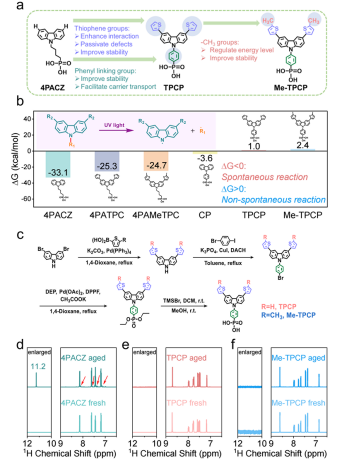
Molecular design mechanism (a) Me-TPCP/TPCP structure; (b) bond breaking reaction ΔG comparison; (d-f) molecular UV stability verification (¹H NMR)
Enhanced stability by π-conjugated backbone
Replacing the traditional alkyl linking group with phenyl group shortens the distance of the key C-N bond with the carbazole ring to form a protective conjugation; introducing thiophene group at the carbazole 3,6 position further extends the conjugation system.
Theoretical validation: TD-DFT calculations show that the design changes the C-N bond breaking reaction from spontaneous (ΔG<0) to non-spontaneous (ΔG>0), and the molecular intrinsic UV stability is significantly improved.
Experimental confirmation: ¹H NMR shows that the 4PACZ structure of the conventional molecule is destroyed after UV aging, while TPCP/Me-TPCP remains unchanged.
Dual functionalization of the thiophene moiety
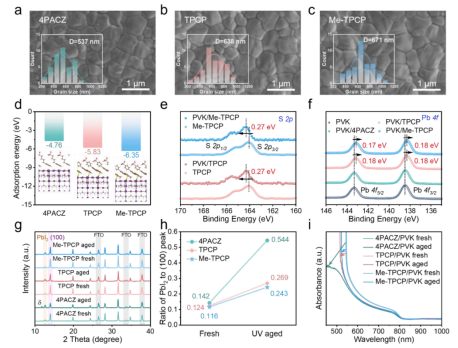
Calcitonite film properties
Strong coordination of the sulfur atom at the tip of the thiophene with the uncoordinated Pb²⁺ ions in the chalcocite (confirmed by XPS shifts) to achieve:
Enhancement of the binding energy of chalcocite to the substrate (adsorption energy increased to -6.35 eV)
Facilitation of chalcocite to form large grains (SEM showed grains up to 671 nm)
Reduction of the defect density of the thin film (15% reduction of traps measured by SCLC)
Methylation fine-tuning properties
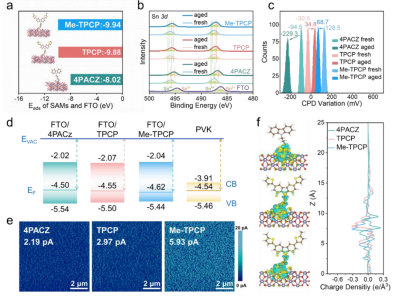
Interfacial charge dynamics
Introduction of methyl group in Me-TPCP stabilizes the molecular structure by p-π hyperconjugation and optimizes the energy level matching, which reduces the hole extraction barrier to 0.84 eV and enhances the conductivity (171% enhancement of c-AFM current strength).
Cell efficiency and stability validation
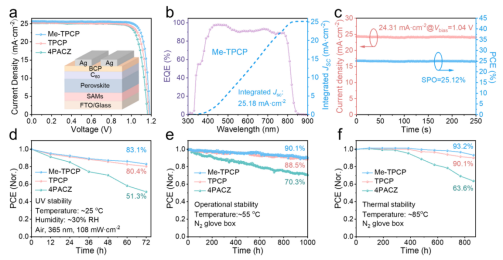
Cell performance (a) J-V curve and photovoltaic parameters (b) Me-TPCP device EQE spectrum and integration current (c) Maximum power point stabilized output (d) UV stability test (e) Operational stability (f) Thermal stability
Using inverted cell with structure of FTO/SAM/Calcite/C60/Ag, Me-TPCP based device achieves: 25.62% ultra-high efficiency
Photovoltaic parameters:

Optimal device current-voltage (J-V) curves vs. parameter table: me-TPCP-PCE=25.62% (VOC=1.185 V, JSC=25.67 mA/cm², FF=84.21%) > TPCP=24.38% > 4PACZ=23.85%.
The EQE spectrum (M-TPCP-based device) matches the integral current (≈Jₛc).
MPPT tracking: Stabilized output of 25.12% efficiency at the maximum power point (Vmax=1.04 V) for 250 seconds, confirming reliability under actual operating conditions;
Superior Stability:
UV Stability: retains 80.4% of initial efficiency (only 51.3% at 4PACZ) after 72 hours of aging under strong UV light (108 mW/cm², 365 nm).
Operational stability: 90.1% of initial efficiency was retained after 1000 hours of exposure to 1 sunlight (N₂ atmosphere).
Thermal stability: 93.2% of initial efficiency was retained after 800 hours of heating at 85°C (N₂ atmosphere).
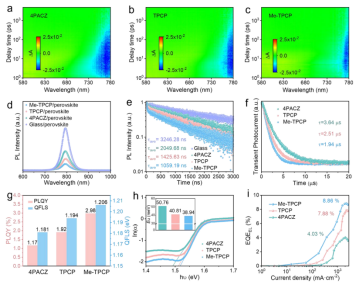
Charge complex suppression (a-c) TAS pseudo-color plots of (a) 4PACZ, (b) TPCP, (c) Me-TPCP (d) Steady-state PL spectra (e) TRPL decay curves (f) TPC decay curves (g) PLQY versus quasi-Fermi energy level splitting (QFLS) (h) Urbach energy calculations (i) electroluminescence EQE curves
Key mechanism validation: Transient absorption spectroscopy (TAS) and fluorescence lifetime test (TRPL) confirm that Me-TPCP has the fastest hole extraction rate (lifetime of only 1649 ps); the low Urbach energy (38.94 meV) and the high electroluminescence efficiency (EQEEL=8.86%) indicate that it is effective in suppressing non-radiative complexation.
The Me-TPCP-based inverted cell achieves 25.62% certified efficiency, and its stabilized output efficiency under MPPT tracking reaches 25.12%, and demonstrates excellent stability in UV, light and high temperature scenarios (>80% after UV aging, and >90% after 1,000 hours of MPPT), which establishes a new paradigm for aging-resistant chalcogenide cells.
Millennia MPPT Multi-Channel Battery Test System
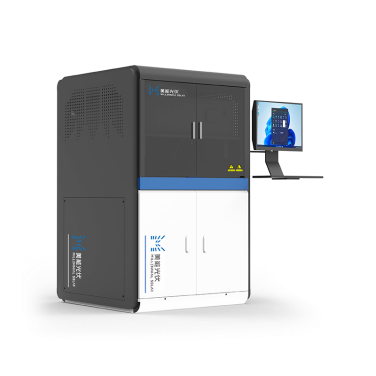
email:market@millennialsolar.com
Millennial MPPT Multi-Channel Battery Test System adopts A+AA+ grade LED sunlight simulator as the aging light source, with its advanced technology and multi-functional design, it provides strong support for the research of Calcium Titanium Solar Cell.
▶ Light Source Grade: A+AA+, Spectral Matching Grade A+, Uniformity Grade A, Long-Time Stability Grade A+
▶ Effective Spot Size: ≥250*250mm (Customizable)
▶ Light Intensity Adjustable: 0.2-1.5sun, Sequentially Adjustable in Steps of 0.1sun
▶ Power Independently Controllable: 300-400 nm/400-750 nm/750-1200 nm
Millennial MPPT multi-channel cell testing system dynamically tracks the maximum power point of a chalcogenide solar cell to optimize power generation. The MPPT data from this study provides direct evidence that the device has the sustained high power output required for commercialization.
Related Products

































































